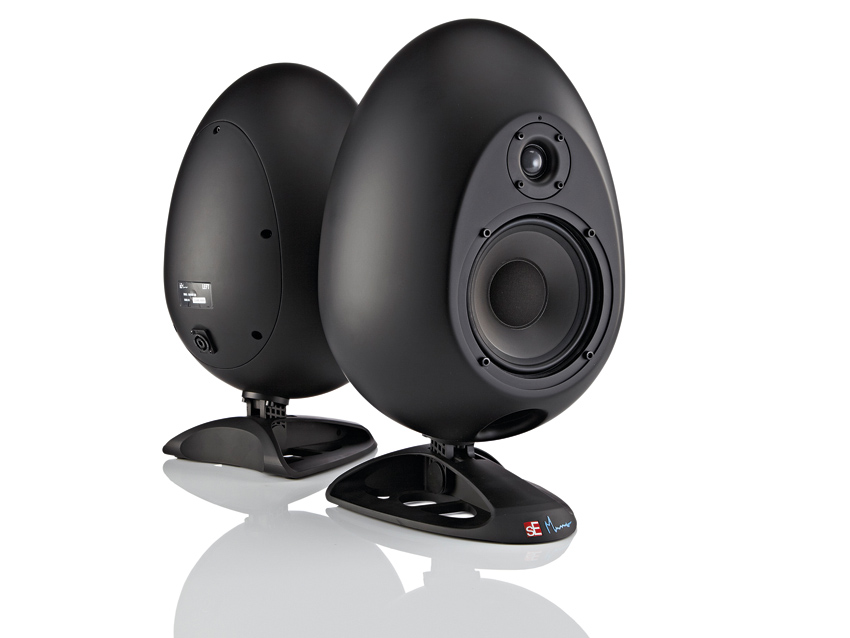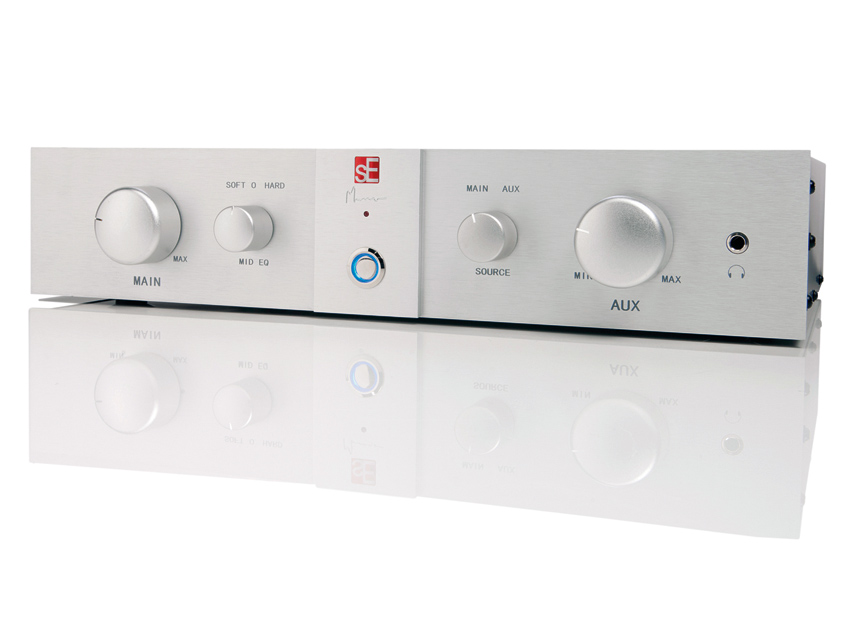MusicRadar Verdict
A fantastic product on all fronts, the Eggs let you hear the music not the speakers.
Pros
- +
Sound; excellent build quality; great pre- and post- purchase customer support.
Cons
- -
None.
MusicRadar's got your back

sE Munro Egg 150 Monitors

sE Munro Egg 150 Monitors
With a few notable exceptions, monitor speaker design has remained pretty constant for a very long time.
Be they horn loaded, high efficiency, ported, transmission line, bi-amped, tri-amped, passively or actively crossed over, they all usually come in a rectangular box built of wood. Recently we have seen some unusual materials come into play - Kevlar bass units and metal tweeter diaphragms; cabinets made of aluminium - but the basic cabinet shape has stayed much the same.
"The stereo image is as accurate as anything we've heard, and transient response is astonishing - not just in the mid and top but right the way down to the bottom."
Shape matters
In the theoretical world, the idea of a spherical cabinet has been around since 1969 and the scientific evidence for why it's ideal is compelling.
One of the problems with the rectangular box is that it causes diffraction of the soundwaves radiating from it, resulting in comb filtering and an uneven frequency response. There are also internal resonances within the cabinet that add to the problems - one of the reasons why studio designers try to avoid parallel walls in room designs - and this, coupled with the diffraction, means the design process always has to accept compromises, which tip over into the electronic design and driver choice.
Spherical cabinets don't have the diffraction problems but do have a resonance (have you ever bounced a beach ball on concrete?) and egg shapes go a long way towards avoiding these issues.
So Andy Munro isn't just trying to catch your eye with this radical new shape - he's trying to avoid the problems he's struggled with for years as a serious speaker designer.
The system
So what do you get? First the Eggs themselves - monocoque shells moulded from a special plastic.
The drivers are mounted on the flattened frontal plane and there's a bass port that faces downwards below the bass driver. The Eggs sit on adjustable stands that enable you to tilt them down from the vertical, not up.
This is because speakers should always be at ear height or slightly higher, never below. Some users may find this a bit uncompromising but in pro audio this is the law, so go with it!
The speakers connect to the amplifier via cables with Speakon connectors. This amplifier has two sets of inputs: balanced XLRs switchable between +4 and -10dB and a pair of unbalanced RCA phonos for connecting domestic level kit.
There are two big volume controls, one for the main XLR inputs and one for the aux phonos. The reason for this is that you can set the levels and then switch between them for direct comparison between your mix and, say, a CD player; very well thought out and very useful.
The other two knobs are for the aforementioned source switching and a three-position EQ switch, labelled Soft, 0 and Hard. This gives you the option of listening flat or with a little midrange cut or boost.
The last front panel control is the power switch which is right where it should be and not on the back.
At the rear of the amp are the connectors, the level switch for the XLR inputs and a switch labelled LED on/off. On the front of each speaker just above the tweeter is a recessed blue LED.
This is to help you align the speakers accurately to your monitoring position. You simply angle the speakers until the LED is at its brightest and then switch it off; a really smart little idea that takes the headache out of aligning them and is another example of the thought that has gone into this design.
The sound
So how do our ovoid friends fare when it comes to the listening test? Well, having installed the system and set it to flat, out came the CDs - and our first reactions were surprise at just how far the bass end extends.
Initially we thought I'd set them up wrong, put them in the wrong place, or that they simply had too much bottom end. Flicking through different styles of music we started to get a grip and began to enjoy it.
It's not that there's too much low end, it's that it's so detailed and frankly, we're not used to hearing it like that from what are, ostensibly, a small to medium-sized pair of speakers.
Listening to own own mixes, all the detail expected was there, right across the frequency spectrum. The stereo image is as accurate as anything we've heard, and transient response is astonishing - not just in the mid and top but right the way down to the bottom.
On tracks where we've struggled to get the mix of lows just right because of difficulties hearing them, there they were in all their detail.
Nowhere to hide
There is no flattery. If it sounds wrong on the Eggs then it is. If we was pleased with how some tracks sounded because we'd got them right, there was also horror at the odd one that had caused concern - because boy do these buggers show up the defects.
The next thing you notice is just how even they sound wherever you are. While sE and Munro have taken pains to give you an easy method to find the sweet spot, as you move around the room you don't get the impression that the sound really changes that much.
HF dispersion is excellent and even on the sofa at the back of the control room there seemed to be less of a bass rise than usual. That's great when the band are sitting behind you as you'll get less fretting about the balance and more time to sit in the monitor position and get on with your work.
Also, handy for those client-pleasing moments, the Eggs go bloody loud without any obvious tonal changes. It's all there whatever level you monitor at, so the odd ear-shattering playback doesn't need to come with any caveats.
Eggs is eggs
What we listen to is probably the most important choice in how we define the sound we create. If our speakers (and our listening environment) are too flattering, or don't give us an accurate picture of what we're doing, we're very likely to sell ourselves short.
The Eggs are a shining example of what can be achieved via thoughtful design and attention to detail. That this level of quality is now available at this price point is likely to be a bit of a wake-up call to quite a few manufacturers and that it comes from sE Munro's first product can only bode very well for the company's future in the loudspeaker market.
Add to that sE's loan-to-buy scheme and zero downtime warranty - check the website - and that price tag starts to look even better.
“A synthesizer that is both easy to use and fun to play whilst maintaining a decent degree of programming depth and flexibility”: PWM Mantis review
“I feel like that song had everything we needed to come back with”: Bring Me The Horizon’s Lee Malia on Shadow Moses, its riff and the secrets behind its tone, and why it was the right anthem at the right time
“I said, ‘Are we sure we can write a song about death?’”: The story of Mike + The Mechanics' classic No.1 The Living Years









